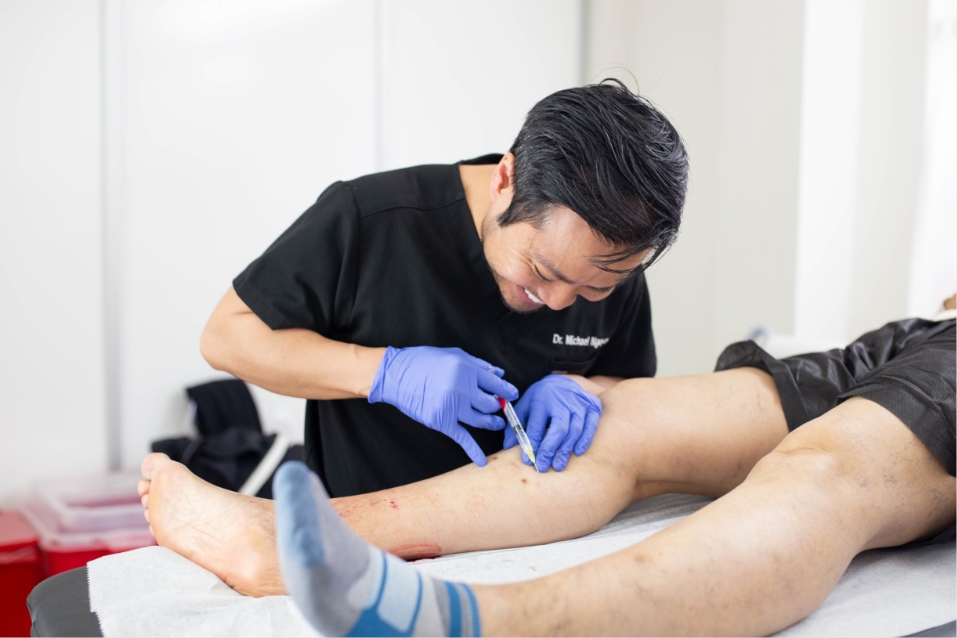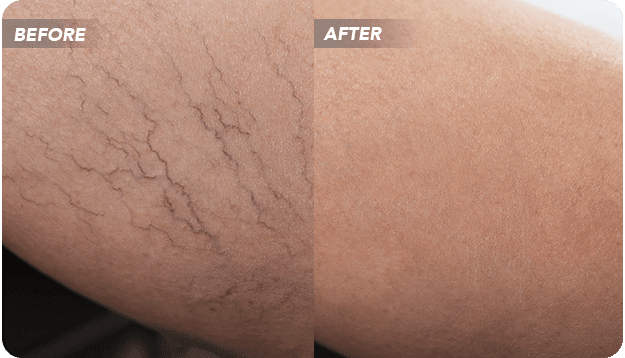1. Chronic venous insufficiency
Chronic venous insufficiency is a relatively common vein condition seen at vein clinics, and it is believed that almost one-third of all Americans suffer from this. This condition affects the large veins of the lower legs.
The veins of the legs have a tough job – they need to transport blood from the feet and legs back to the heart against gravity. To help them in this process, the veins have in-built tiny, one way doors called valves. Once the blood from the feet and legs flows upwards past them, the valves seal shut, preventing it from falling back down into the legs.

In venous insufficiency, however, the valves in two key veins of the legs – called the saphenous veins – malfunction. As a result, blood which is supposed to go back to the heart instead trickles down into the legs and stays there. Over time, the excess, backed up blood causes the pressure in the smaller leg veins to rise. This condition is called venous insufficiency, and it largely goes unrecognized by several people.
While venous insufficiency by itself does not have any specific symptoms in the initial stages, it is essentially a forerunner of several other vein problems, which are discussed below.
2. Visible veins like varicose veins and spider veins
Often, the first indication that a person has venous insufficiency might be in the form of cosmetic problems like spider veins, or even varicose veins. The increased blood pressure in the smaller leg veins causes the veins to swell up and distort, giving the classic appearance of varicose veins and spider veins. What exactly is the difference between the two?

Varicose veins are swollen veins that bulge out from beneath the surface of your skin. They appear as twisted or knotted ropes and are commonly present on the thighs and lower legs.
Spider veins, on the other hand, look like small blemishes. They may be red, purple, or blue in color, and they form streaks that interlace together like a spider’s web. Occasionally, these may be slightly raised, but usually they are level with the skin surface. A few spider veins on your legs or face are not uncommon as you grow older. However, if you have several dotting your legs – especially on the inner side of your ankles, you could very well be having venous insufficiency.
3. Throbbing leg pain and leg cramps
The high pressure in the lower leg veins can manifest outwardly as pain. This can either be in the form of vague, non-specific leg pain, or it could be severe throbbing pain that runs across the length of your leg. The pain is usually worse at the end of a long day – after you have been on your feet for long periods.
Pain can also manifest in the form of leg cramps. These cramps occur because the pooled blood in the leg breaks down into toxic products, that causes the leg muscles to spasm. These leg cramps usually occur at night, and can be severe enough to wake you up from a deep sleep.
4. Visible leg swelling
The pooled blood can seep out of the blood vessels into the surrounding tissues. This excess fluid buildup in the tissues causes your legs to swell. The swelling is usually more noticeable around your ankles and feet. Although several different medical conditions can cause leg swelling, you may notice that swelling due to venous insufficiency only appears in the after you have been sitting or standing around for long periods of time. The swelling reduces after you put your feet up, or even walk around.
5. Restless legs syndrome
This is also known as Willis-Ekbom disease. This disease is characterized by an uncomfortable sensation – tingling, itching or burning, which only gets relieved if you stretch, shake or move your legs. These uncomfortable feelings only begin when you are at rest – sitting or lying down, usually at night. While there are several causes for this condition, venous insufficiency is believed to be a major contributor, and treating underlying vein disease can help relieve the symptoms of this condition.
Vein Treatment Clinic New Jersey: Experience state of the art care for all your vein conditions
If you have any of the above conditions, then it is time to visit a vein clinic, which offers more than varicose vein treatments! The Vein Treatment Clinic in New Jersey offers advanced, minimally invasive vein treatment that can help you with all of the above vein conditions. At our vein clinic, you can consult with one of our experienced vein specialists, who will help diagnose whether or not you have venous insufficiency, and offer you a personalized treatment plan accordingly. Our vein consultants see patients at different locations in New Jersey.
- Dr. Sareh Rajaee: A Yale trained vascular surgeon, highly experienced in managing all forms of vein disease. Dr. Rajaee sees patients at our vein clinic in Clifton, located on Route 46-E, near the Garden State Parkway, just past a Ford dealership.
- Dr. Todd Kobrinski: A double board certified physician who is an expert in cardiovascular care. Dr. Kobrinski sees patients at our vein clinic in Paramus, just off the Garden State parkway, near a popular furniture showroom. Dr. Kobrinski is also seeing patients at a new location in Woodland Park, NJ.
To learn more about our accredited vein centers, please visit www.veintreatmentclinic.com. Our spider and varicose vein treatment clinics are certified by the IAC as vascular imaging centers and vein treatment centers of excellence. We have local affiliates in New York, Long Island, New Jersey, Texas and California, all of which are held to the highest standards of patient-centered, compassionate, care. We offer the latest technology at every location, and our harvard-trained medical directors lead a collaborative effort to ensure the best outcome for every patient we meet. You may book an appointment online, or call.









